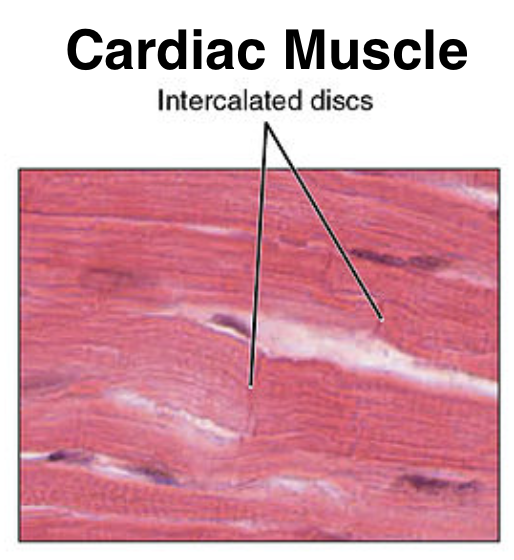
The specialized cardiac muscle which is striated like skeletal muscle. Cardiomyocytes or the cardiac cells are uninucleate cylindrical and elongated.

Cardiac muscle tissue is a specialized organized type of tissue that only exists in the heart.
Special features of cardiac muscle. Special Features of Cardiac Muscle Metabolism The basic principles of cellular metabolism apply to cardiac muscle the same as for other tissues but there are some quantita-tive differences. Most important under resting condi-tions cardiac muscle normally consumes fatty acids to supply most of its energy instead of carbohydrates about 70 per cent of the energy is derived from fatty acids. Features of cardiac muscles.
Listed below are three features of cardiac muscles. Cardiac muscles are involuntary muscles. They are involved in continuous rhythmic contraction and relaxation.
Cardiomyocytes or the cardiac cells are uninucleate cylindrical and elongated. They are responsible for initiating and controlling the heartbeat. Functionally pacemaker cells regulate the electrical impulses of the heart thus playing a direct role in maintaining the heart rate.
The muscle shares some features with the remaining two muscles namely. Cardiac muscle tissue works to keep your heart pumping through involuntary movements. This is one feature that differentiates it from skeletal muscle tissue which you can control.
Three features of cardiac muscles are. Cardiac muscles are involuntary muscles that contract rapidly but do not get fatigued. The cells of cardiac muscles are cylindrical branched and uninucleate.
They control the contraction and relaxation of the heart. Cardiac muscle also called myocardium in vertebrates one of three major muscle types found only in the heart. Cardiac muscle is similar to skeletal muscle another major muscle type in that it possesses contractile units known as sarcomeres.
This feature however also distinguishes it from smooth muscle the third muscle type. Cardiac muscle differs from skeletal muscle in that it exhibits rhythmic. Another feature of cardiac muscle is its relatively long action potentials in its fibers having a sustained depolarization plateau The plateau is produced by Ca entry though voltage-gated calcium channels in the sarcolemma of cardiac muscle fibers.
Of the three types of muscle tissue cardiac muscle tissue is the one thats near and dear to my heart because well its in my heartIn fact thats the only place youll find cardiac muscle tissue and the very word cardiac literally means relating to the heart The cells that make up cardiac muscle are called cardiomyocytes or cardiocytes and together they make up. Cardiac muscle exists only within the heart of animals. It is a specialized form of muscle evolved to continuously and repeatedly contract providing circulation of blood throughout the body.
The heart is a relatively simple organ. Through all the twists. Cardiac muscle tissue is a specialized organized type of tissue that only exists in the heart.
It is responsible for keeping the heart pumping and blood circulating around the body. Cardiac muscle is specialized tissue that is found only in the heart. It has characteristics similar to both smooth and skeletal muscle tissue as well as specialized properties that allow it to function with fast but sustained contractions rapid conduction and coordinated movement.
Cardiac muscle tissue or myocardium forms the bulk of the heart. The heart wall is a three-layered structure with a thick layer of myocardium sandwiched between the inner endocardium and the outer epicardium also known as the visceral pericardium. The inner endocardium lines the cardiac chambers covers the cardiac valves and joins with the endothelium that lines the blood vessels that.
Cardiac muscle is short branched appears striated and has a single central nucleus. It contracts to pump blood and is found only in the heart. Smooth muscle is short spindle-shaped has no evident striation and contains a single nucleus in each fiber.
Sodium channel inactivate so sodium movement in decreases. What significant change happens to ion channels and ion movement during plateau phase. Potassium inward rectifier channels close and calcium L-type channel open so potassiums movement out decreases and calcium moves in.
Special Features of the Myocardium Cardiac muscle cells are lightly striated striped based on alternating actin and myosin filaments as seen in skeletal muscle cells. Unlike skeletal muscle cells however cardiac muscle cells have a single nucleus instead of multiple nuclei. Also cardiac muscle tissue is involuntarily controlled.
Each cardiac muscle cell is in contact with another three or four cardiac muscle cells. The overlapping region in each cell forms finger-like extensions in the cell membraneThese structures are called as intercalated disksThe structure of the intercalated disk forms gap junctions and desmosomes between the two cells allowing the passage of electrochemical signals between the two cells. Cardiac muscle is the main type of tissue found in the human heart.
Watch the full video here to learn everything about histology of cardiac muscle. The specialized cardiac muscle which is striated like skeletal muscle. This muscle type is found solely in the heart.
It makes up the walls of the heart and causes it to contract. These contractions cause the internal movement circulation of blood within the body. Fortunately cardiac muscle like smooth muscle is an.
Unique anatomical feature of the Heart muscle is the presence of intercalated discs. They hold the heart cells together and allow the conduction of impulses between the cells. Another feature that is unique to cardiac muscle tissue is autorhythmicity.
Cardiac muscle tissue is able to set its own contraction rhythm due to the presence of pacemaker cells that stimulate the other cardiac muscle cells. The pacemaker cells normally receive inputs from the nervous system to increase or decrease the heart rate depending on.